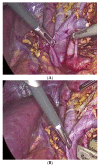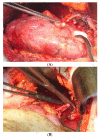The Evolution of Living Donor Nephrectomy Program at A Hellenic Transplant Center. Laparoscopic vs. Open Donor Nephrectomy: Single-Center Experience
- PMID: 33809339
- PMCID: PMC8001196
- DOI: 10.3390/jcm10061195
The Evolution of Living Donor Nephrectomy Program at A Hellenic Transplant Center. Laparoscopic vs. Open Donor Nephrectomy: Single-Center Experience
Abstract
Since its introduction in 1995, laparoscopic nephrectomy has emerged as the preferred surgical approach for living donor nephrectomy. Given the ubiquity of the surgical procedure and the need for favorable outcomes, as it is an elective operation on otherwise healthy individuals, it is imperative to ensure appropriate preoperative risk stratification and anticipate intraoperative challenges. The aim of the present study was to compare peri-and postoperative outcomes of living kidney donors (LD), who had undergone laparoscopic nephrectomy (LDN), with a control group of those who had undergone open nephrectomy (ODN). Health-related quality of life (QoL) was also assessed using the validated SF-36 questionnaire. Data from 252 LD from a single transplant center from March 2015 to December 2020 were analyzed retrospectively. In total, 117 donors in the LDN and 135 in the ODN groups were assessed. Demographics, type of transplantation, BMI, duration of surgery, length of hospital stay, peri- and postoperative complications, renal function at discharge and QoL were recorded and compared between the two groups using Stata 13.0 software. There was no difference in baseline characteristics, nor in the prevalence of peri-and postoperative complications, with a total complication rate of 16% (mostly minor, Clavien-Dindo grade II) in both groups, while a different pattern of surgical complications was noticed between them. Duration of surgery was significantly longer in the ODN group (median 240 min vs. 160 min in LDN, p < 0.01), warm ischemia time was longer in the LDN group (median 6 min vs.2 min in ODN, p < 0.01) and length of hospital stay shorter in the LDN group (median 3 days vs. 7 days in ODN). Conversion rate from laparoscopic to open surgery was 2.5%. There was a drop in estimated glomerular filtration rate (eGFR) at discharge of 36 mL/min in the LDN and 32 mL/min in the ODN groups, respectively (p = 0.03). No death, readmission or reoperation were recorded. There was a significant difference in favor of LDN group for each one of the eight items of the questionnaire (SF1-SF8). As for the two summary scores, while the total physical component summary (PCS) score was comparable between the two groups (57.87 in the LDN group and 57.07 in the ODN group), the mental component summary (MCS) score was significantly higher (62.14 vs. 45.22, p < 0.001) in the LDN group. This study provides evidence that minimally invasive surgery can be performed safely, with very good short-term outcomes, providing several benefits for the living kidney donor, thereby contributing to expanding the living donor pool, which is essential, especially in countries with deceased-donor organ shortage.
Keywords: kidney transplantation; laparoscopic; living donation; outcomes; quality of life.
Conflict of interest statement
The authors declare no conflict of interest.
Figures





References
-
- Wolfe R.A., Ashby V.B., Milford E.L., Ojo A.O., Ettenger R.E., Agodoa L.Y., Held P.J., Port F.K. Comparison of mortality in all patients on dialysis, patients on dialysis awaiting transplantation, and recipients of a first cadaveric transplant. N. Engl. J. Med. 1999;341:1725–1730. doi: 10.1056/NEJM199912023412303. - DOI - PubMed
-
- Ratner L.E., Ciseck L.J., Moore R.G., Cigarroa F.G., Kaufman H.S., Kavoussi L.R. Laparoscopic live donor nephrectomy. Transplantation. 1995;60:1047–1049. - PubMed
LinkOut - more resources
Full Text Sources
Other Literature Sources
Research Materials
Miscellaneous

